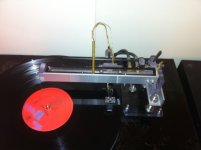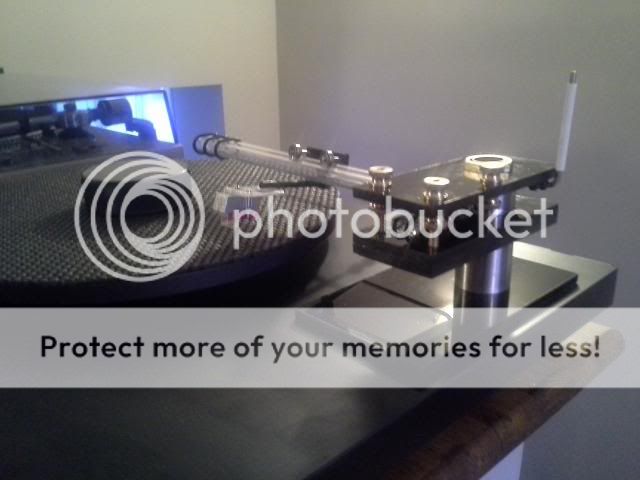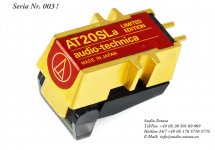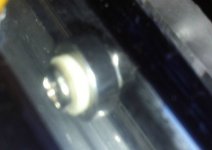VTA Adjustment
ChrisG, I like this better than the real answer. Only Grizzlys around here drive big pickup trucks though.
Ralf, That does sound like a good idea, but that's not it.
The cartridge is attached to a piece that was cut from the composite shaft of a hockey stick. It was free to me. But some unfortunate parent spent $100+ on a stick that broke. I believe the better ones have some carbon fiber mixed with glass fibre and are reasonably well damped. I couldn't find any thick lexan.
I may use some of this composite shaft for the horizontal piece that Colin recommends to support the other end of the glass tube. Has anybody tried this material?
Hugh
A grizzly bear's third toenail?
ChrisG, I like this better than the real answer. Only Grizzlys around here drive big pickup trucks though.
HTML:
It looks like one of those sheet metal "squeeze to release" spring clips.Ralf, That does sound like a good idea, but that's not it.
The cartridge is attached to a piece that was cut from the composite shaft of a hockey stick. It was free to me. But some unfortunate parent spent $100+ on a stick that broke. I believe the better ones have some carbon fiber mixed with glass fibre and are reasonably well damped. I couldn't find any thick lexan.
I may use some of this composite shaft for the horizontal piece that Colin recommends to support the other end of the glass tube. Has anybody tried this material?
Hugh
Bill,
The L by its architecture is very stiff, and with the way it's mounted too I'm sure helps. I've used no damping and no ring that even approaches even close to one second, just a thud. I'm realizing I found some damn fine bearings, 5 pairs in total and the tonearm wire would dominate any friction period in a large degree, hence the way I slung it above.
A question was asked earlier on the AT120e, I highly recommend it for a MM and you need to spend a lot more to better it, however any like an MC for its non linear high frequency resonance, and tipped up treble, best 100 dollars spent and highly musically resolving and will sound better than a budget mc.
Colin
The L by its architecture is very stiff, and with the way it's mounted too I'm sure helps. I've used no damping and no ring that even approaches even close to one second, just a thud. I'm realizing I found some damn fine bearings, 5 pairs in total and the tonearm wire would dominate any friction period in a large degree, hence the way I slung it above.
A question was asked earlier on the AT120e, I highly recommend it for a MM and you need to spend a lot more to better it, however any like an MC for its non linear high frequency resonance, and tipped up treble, best 100 dollars spent and highly musically resolving and will sound better than a budget mc.
Colin
looks like we are evolving back to the Cantus albeit an inside out one.
That's exactly what I was also thinking same vertical and horizontal properties .. however , this 2 rodded animal has a larger contact surface .. perhaps also deviding resonances over two glass tubes , instead of one . who knows what else
same vertical and horizontal properties .. however , this 2 rodded animal has a larger contact surface .. perhaps also deviding resonances over two glass tubes , instead of one . who knows what else  I also strongly believe that the mass of the carrier has a lot to do with a dead construcion .. as we need mass and materials to dissipate the energy .
I also strongly believe that the mass of the carrier has a lot to do with a dead construcion .. as we need mass and materials to dissipate the energy .
I'm happy to hear positive news about this new arm approach !!
THX
Paul
That's exactly what I was also thinking
I'm happy to hear positive news about this new arm approach !!
THX
Paul
Last edited:
The cartridge is attached to a piece that was cut from the composite shaft of a hockey stick. ...
I may use some of this composite shaft for the horizontal piece that Colin recommends to support the other end of the glass tube. Has anybody tried this material?
Hugh
You should use a puck for a record weight!
looks like we are evolving back to the Cantus albeit an inside out one.
That's exactly what I was also thinkingsame vertical and horizontal properties .. however , this 2 rodded animal has a larger contact surface .. perhaps also deviding resonances over two glass tubes , instead of one . who knows what else
I also strongly believe that the mass of the carrier has a lot to do with a dead construcion .. as we need mass and materials to dissipate the energy .
I'm happy to hear positive news about this new arm approach !!
THX
Paul
Paul,
The Cantus never left the thoughts myself or any others, similar in the respect they both use two bearings. I think this one rather takes the V concept to a whole new stratosphere
Rega has their own anti mass philosophy, and based on their sales numbers it works for them, IMHO their tables do sound very musicial while not being the king of accuracy. Perhaps putting all of our minds together here we can rewrite some areas of prior ways of thinking, physics is set in stone of course but its too simple to just add mass to everything and hope for the best
Colin
Hi Colin ,
I'll soon create some time to get started with this new concept . and of course will report my findings too .
I see less to none differences between the stock cantus tube and this double rodded creature / they both seem to provide the same load for the bearings .. the sort of concave shape the bearings are facing . hope I am using the right words to express my ideas at this point .
As for mass disscusion :
At the moment the platter and bearing of my DIY TT ) ( Lenco L70 ) are directly mounted onto a heavy birchply sandwich stack of aprox. 18 inch square and 7 inches in height . I can brutaly knock on the plinth during playingback w/o the slightest arm disturbance , or noise of any kind . NO audible bearing noise is getting into the plinth as well , and or is dissipated
extremely well. this alone makes it a true enjoyable and musical piece .
Yes , it's a bitch to move her from the wallmount shelf once in a while but I will probably not return to use one of the other decks I got around here .
but I will probably not return to use one of the other decks I got around here .
I admit and realize that most of us will be using their tonearms on more common stock turntables . which may call for another approach of dampening the arm , or better said killing resonances . In my case here I figure that the more sturdy or massive the connection methode of the arm carrier onto the plinth is getting , the better the results are getting too .
THX,
Paul
I'll soon create some time to get started with this new concept . and of course will report my findings too .
I see less to none differences between the stock cantus tube and this double rodded creature / they both seem to provide the same load for the bearings .. the sort of concave shape the bearings are facing . hope I am using the right words to express my ideas at this point .
As for mass disscusion :
At the moment the platter and bearing of my DIY TT ) ( Lenco L70 ) are directly mounted onto a heavy birchply sandwich stack of aprox. 18 inch square and 7 inches in height . I can brutaly knock on the plinth during playingback w/o the slightest arm disturbance , or noise of any kind . NO audible bearing noise is getting into the plinth as well , and or is dissipated
extremely well. this alone makes it a true enjoyable and musical piece .
Yes , it's a bitch to move her from the wallmount shelf once in a while
 but I will probably not return to use one of the other decks I got around here .
but I will probably not return to use one of the other decks I got around here . I admit and realize that most of us will be using their tonearms on more common stock turntables . which may call for another approach of dampening the arm , or better said killing resonances . In my case here I figure that the more sturdy or massive the connection methode of the arm carrier onto the plinth is getting , the better the results are getting too .
THX,
Paul
Last edited:
I've had some time to listen to this arm, I was wrong, Bass is not lighter just as heavy but tight and more accuracy to the the recording!. The bass issue was too light a tracking weight, the at120 likes the upper end about 1.6g. Easy to set tracking force, with the tube tube as noted by Bill and PDR.
Sound wise, I'm not going to bore you with the details, I'm not a fan of waxing lyrically, but I will say prepare to be in for a revelation in sounds, the prat and imaging is unbelievable .
.
Colin
Sound wise, I'm not going to bore you with the details, I'm not a fan of waxing lyrically, but I will say prepare to be in for a revelation in sounds, the prat and imaging is unbelievable
Colin
Sound wise, I'm not going to bore you with the details, I'm not a fan of waxing lyrically, but I will say prepare to be in for a revelation in sounds, the prat and imaging is unbelievable.
Colin
Yes, imaging is what I've noticed the most.
With my open baffle speakers the arm is spectacular, as
I'm sure it is with others.
This will be interesting to see what others come up with.
Videos would be cool.....
AT120E
Thanks Colin, I have one on order.
Hugh
A question was asked earlier on the AT120e, I highly recommend it for a MM and you need to spend a lot more to better it, however any like an MC for its non linear high frequency resonance, and tipped up treble, best 100 dollars spent and highly musically resolving and will sound better than a budget mc.
Colin
Thanks Colin, I have one on order.
Hugh
Record Weight
nezbleu,
I wonder? Might be good.
Hugh
You should use a puck for a record weight!
nezbleu,
I wonder? Might be good.
Hugh
I'm using a puck while a friend crafts a weight for the Rega.
PDR,
Well I'll be pucked. I wondered what that was a few days back.
Hugh
Audio Technica AT20SLa
It's this one that I eagerly wanna put to use with my next LT arm .
so not AT12SLa as I mentioned in my earlier post .
FWIW .. I have heard rumors about a serious timespan for most AT carts to settle the
suspension , 50 hrs or more seem to be a minimum . also .. tracking at some higher VTF during that break-in periode . So you might wanna check the results on a lower VTF afterwards .
THX ,
Paul
It's this one that I eagerly wanna put to use with my next LT arm .
so not AT12SLa as I mentioned in my earlier post .
FWIW .. I have heard rumors about a serious timespan for most AT carts to settle the
suspension , 50 hrs or more seem to be a minimum . also .. tracking at some higher VTF during that break-in periode . So you might wanna check the results on a lower VTF afterwards .
THX ,
Paul
Attachments
Hi Chris,
I still use a spacer to center the bearing and a top hat at each side but the bearing center is firmly bolted in place. I use a small bolt for the bearing, really simple to set up and requires no gluing. The polycarbonate T for the carriage is tapped for the bolt.
Colin
I still use a spacer to center the bearing and a top hat at each side but the bearing center is firmly bolted in place. I use a small bolt for the bearing, really simple to set up and requires no gluing. The polycarbonate T for the carriage is tapped for the bolt.
Colin
Attachments
Last edited:
When I built the first prototype of the dual tube, it was my goal to keep the
weight down as low as possible. Since the 2 bearings dont need to "slide" on a bushing, or "seat" themselves at a slight angle on each side of the a single tube, I figured why not just affix them permanently. I could see no reason to have to remove the bearings, so why add the additional mass of bolts, shims, bushings, nuts etc.
The cost of one of these arms, including bearings, is right around $8...I have a removable and adjustable headshell that can be fitted to any of the arms. I have 4 now, with 2 different headshells.
What I did was to fit a small piece of carbon tube, hollow 3mm.....the same tube as the wand itself, into the 3mm opening of the bearing. I cut these pieces with my Dremmel to fit for width. These I superglued in place, and at the same time glued small brass rods that fit into the carbon tube and glued them into place as well. Two holes drilled into the acrylic carriage to fit the
rods, you guessed it glued in place.
So now the whole bearing assembly weight is only that of the bearings themselves, the small 3mm carbon tubes, and the brass rods. Tweaking the
alignment of the bearings was done in a few minutes using two small needle nose pliers on the brass rod.
It worked really well and, if I remember correctly, the wand without cartridge
is right around 13 grams, including the 5 gr counter weight.
You can see the brass rods in these pics....
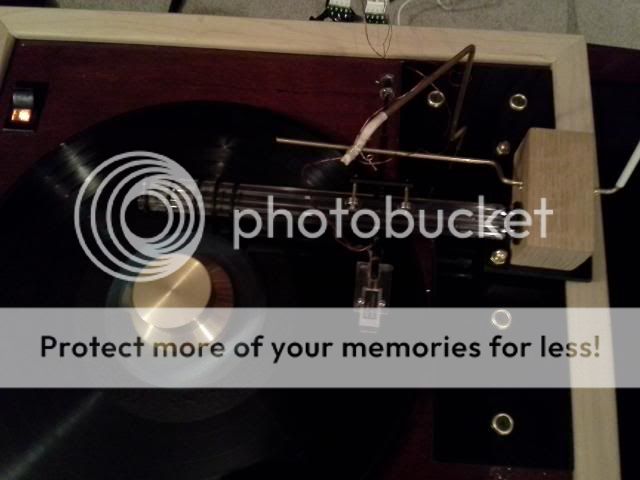
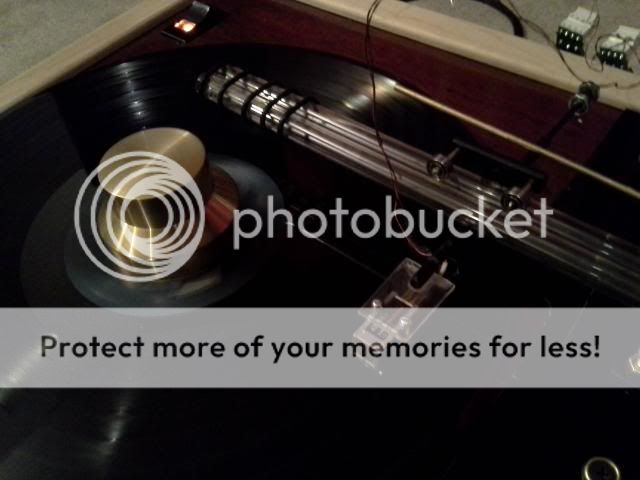
weight down as low as possible. Since the 2 bearings dont need to "slide" on a bushing, or "seat" themselves at a slight angle on each side of the a single tube, I figured why not just affix them permanently. I could see no reason to have to remove the bearings, so why add the additional mass of bolts, shims, bushings, nuts etc.
The cost of one of these arms, including bearings, is right around $8...I have a removable and adjustable headshell that can be fitted to any of the arms. I have 4 now, with 2 different headshells.
What I did was to fit a small piece of carbon tube, hollow 3mm.....the same tube as the wand itself, into the 3mm opening of the bearing. I cut these pieces with my Dremmel to fit for width. These I superglued in place, and at the same time glued small brass rods that fit into the carbon tube and glued them into place as well. Two holes drilled into the acrylic carriage to fit the
rods, you guessed it glued in place.
So now the whole bearing assembly weight is only that of the bearings themselves, the small 3mm carbon tubes, and the brass rods. Tweaking the
alignment of the bearings was done in a few minutes using two small needle nose pliers on the brass rod.
It worked really well and, if I remember correctly, the wand without cartridge
is right around 13 grams, including the 5 gr counter weight.
You can see the brass rods in these pics....


pDR,
I'm not a fan of a permanent fix since it doesn't allow exchanging bearings. To be honest. The movement is so smooth weight doesn't really matter much at all bow about 35 grams . In fact going too low will be a detriment for Mc cartridges. The bolt weighs barely a half gram, it's tiny and allows much more option, I've tried to avoid glue as much as possible and with the bolts it avoids errors in alignments
. In fact going too low will be a detriment for Mc cartridges. The bolt weighs barely a half gram, it's tiny and allows much more option, I've tried to avoid glue as much as possible and with the bolts it avoids errors in alignments  .
.
Colin
I'm not a fan of a permanent fix since it doesn't allow exchanging bearings. To be honest. The movement is so smooth weight doesn't really matter much at all bow about 35 grams
Colin
- Home
- Source & Line
- Analogue Source
- DIY linear tonearm
